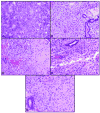Progestin intrauterine device in an adolescent with grade 2 endometrial cancer
- PMID: 22270425
- PMCID: PMC3266511
- DOI: 10.1097/AOG.0b013e318234d97c
Progestin intrauterine device in an adolescent with grade 2 endometrial cancer
Abstract
Background: The treatment of endometrial cancer in young women who desire future fertility poses several challenges. Oral progestin and progestin-releasing intrauterine devices (IUDs) have been shown to result in regression of endometrial hyperplasia and grade 1 endometrioid endometrial carcinoma. However, limited data are available on the use of these methods in women with grade 2 disease.
Case: An 18-year-old nulliparous woman was diagnosed with a grade 2 endometrial adenocarcinoma. She desired future fertility and therefore underwent placement of a levonorgestrel-releasing IUD. The patient subsequently underwent endometrial sampling every 3 months and remained disease-free 13 months after initial IUD placement.
Conclusion: A progestin-releasing IUD may be a valid treatment option for grade 2 endometrial cancer in young women who desire to retain fertility.
Conflict of interest statement
Figures

Comment in
-
Endometrial cancer: potential treatment and prevention with progestin-containing intrauterine devices.Obstet Gynecol. 2012 Feb;119(2 Pt 2):419-420. doi: 10.1097/AOG.0b013e3182444f15. Obstet Gynecol. 2012. PMID: 22270423 No abstract available.
References
-
- Duska LR, Garrett A, Rueda BR, Haas J, Chang Y, Fuller AF. Endometrial cancer in women 40 years old or younger. Gynecol Oncol. 2001;83:388–93. - PubMed
-
- Gallup DG, Stock RJ. Adenocarcinoma of the endometrium in women 40 years of age or younger. Obstet Gynecol. 1984;64:417–20. - PubMed
-
- Ota T, Yoshida M, Kimura M, Kinoshita K. Clinicopathologic study of uterine endometrial carcinoma in young women aged 40 years and younger. Int J Gynecol Cancer. 2005;15:657–62. - PubMed
-
- Jadoul P, Donnez J. Conservative treatment may be beneficial for young women with atypical endometrial hyperplasia or endometrial adenocarcinoma. Fertil Steril. 2003;80:1315–24. - PubMed
-
- Chiva L, Lapuente F, Gonzalez-Cortijo L, Carballo N, Garcia JF, Rojo A, Gonzalez-Martin A. Sparing fertility in young patients with endometrial cancer. Gynecol Oncol. 2008;111:S101–4. - PubMed
Publication types
MeSH terms
Substances
Grants and funding
LinkOut - more resources
Full Text Sources

